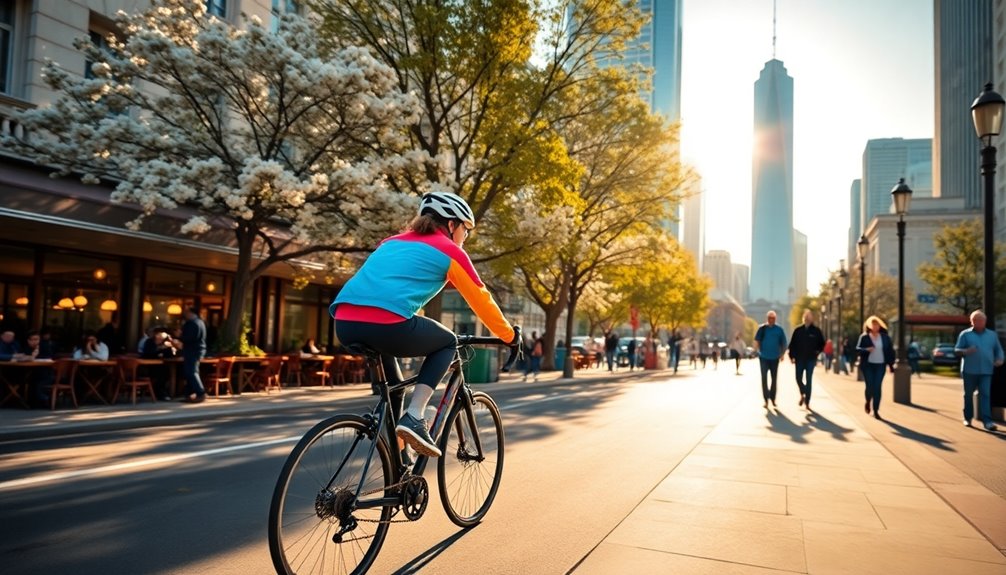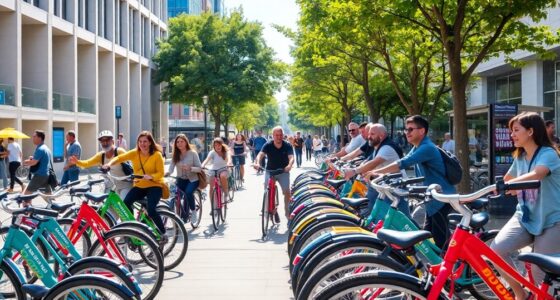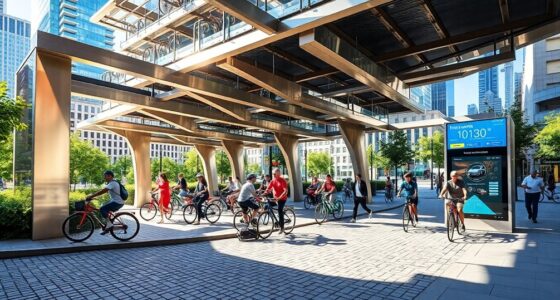Integrating cycling into your daily commute can boost your cardiovascular fitness while cutting down on carbon emissions. Start by assessing your commute distance accurately, then choose the right bike that fits your needs. Explore your local cycling infrastructure, like bike lanes and paths, to find safe routes. Prioritize safety by wearing a helmet and following traffic signals. By making cycling a part of your routine, you'll enjoy both health benefits and a greener lifestyle. There's much more to discover!
Key Takeaways
- Assess your commute distance using GPS or GIS software to determine the most suitable cycling route.
- Choose the right bicycle type based on your urban environment and personal comfort needs.
- Familiarize yourself with local cycling infrastructure, including bike lanes and paths, for safer travel.
- Incorporate safety measures such as wearing a helmet, using lights, and signaling turns to enhance your cycling experience.
- Combine cycling with public transport by using bike racks to extend your travel range efficiently.
Understanding the Benefits of Cycling

Cycling not only gets you from point A to B but also offers a multitude of benefits that can enhance your overall quality of life. It significantly boosts your cardiovascular fitness, strengthens your heart, and reduces the risk of serious diseases like stroke and heart attack.
Plus, it's a low-impact exercise that's gentle on your joints. Mentally, cycling releases endorphins, improving your mood and reducing stress. You'll also find that it enhances your focus and clarity, making you feel more accomplished.
Environmentally, you're cutting down on carbon emissions and helping to reduce traffic congestion. Economically, you save on fuel and maintenance costs, while socially, cycling opens up opportunities for interaction and exploration, making your daily routine more enjoyable. Additionally, incorporating gentle stretching before and after your cycling can help alleviate any muscle tension and enhance overall comfort during your commute.
Assessing Your Commute Distance
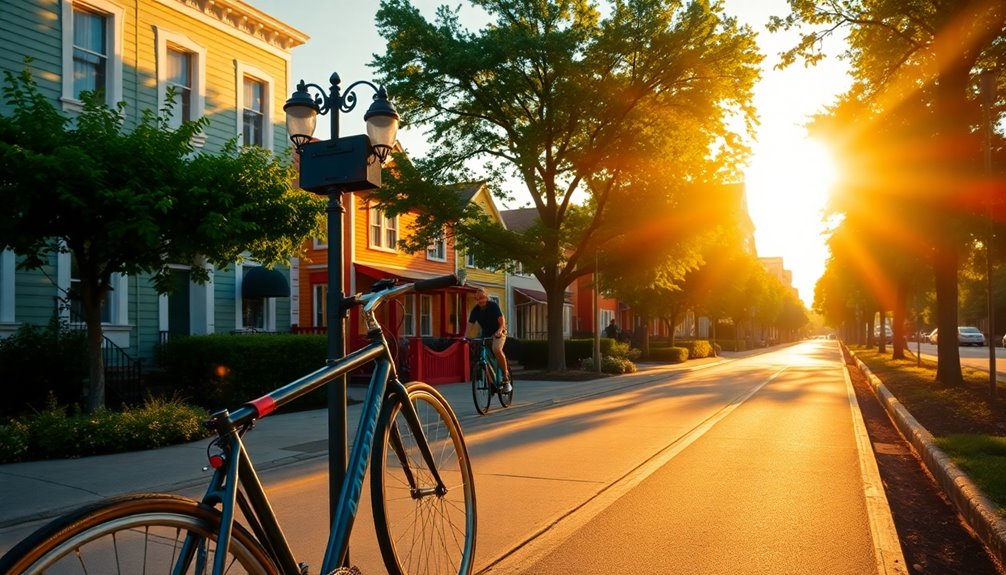
To fully enjoy the benefits of cycling, it's important to assess the distance of your daily commute. Start by using GPS devices for accurate measurements, as they provide minimal deviation from actual routes.
You can also consider GIS software, which calculates the shortest paths, but be aware it may overestimate distances. Self-estimated distances are often less reliable, while straight-line calculations can significantly underestimate your route.
Remember that factors like urban or suburban settings, workplace location, and available infrastructure can all influence how far you'll cycle.
Choosing the Right Bicycle for Your Needs

What type of bike suits your commuting needs best? If you're navigating urban environments, a city bike with a strong frame and thicker tires might be ideal.
For varied terrains, consider a hybrid bike that balances comfort and efficiency. If speed is your focus, a road bike excels on smooth roads.
Need to combine cycling with public transport? A folding bike's compact design makes it a great choice. For longer or hilly commutes, an e-bike provides pedal assistance.
Pay attention to frame material, tire size, and gearing options when selecting. Look for ergonomic features like adjustable seats and handlebars to enhance comfort.
Finally, keep your budget in mind, ensuring you choose a bike that fits your lifestyle and maintenance needs.
Exploring Local Cycling Infrastructure
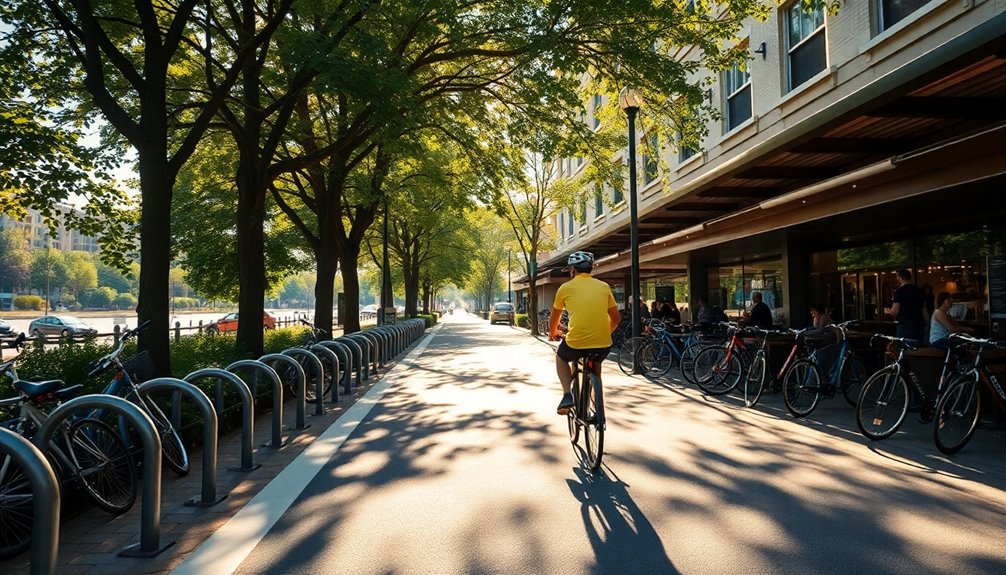
Finding the right bike is just the beginning of your commuting journey; understanding the local cycling infrastructure can greatly enhance your experience.
Familiarize yourself with the types of lanes available, like conventional bicycle lanes, protected bicycle lanes, and painted buffer lanes. These options improve safety by keeping you separated from traffic.
Understanding the different types of bike lanes enhances safety by keeping cyclists separated from traffic.
Off-street bike paths offer a peaceful alternative, while contraflow bicycle lanes let you navigate one-way streets safely.
Additionally, using bike racks on public transit can expand your travel range.
Embrace the benefits of cycling infrastructure, from reduced traffic congestion to improved public health.
Planning Your Cycling Route
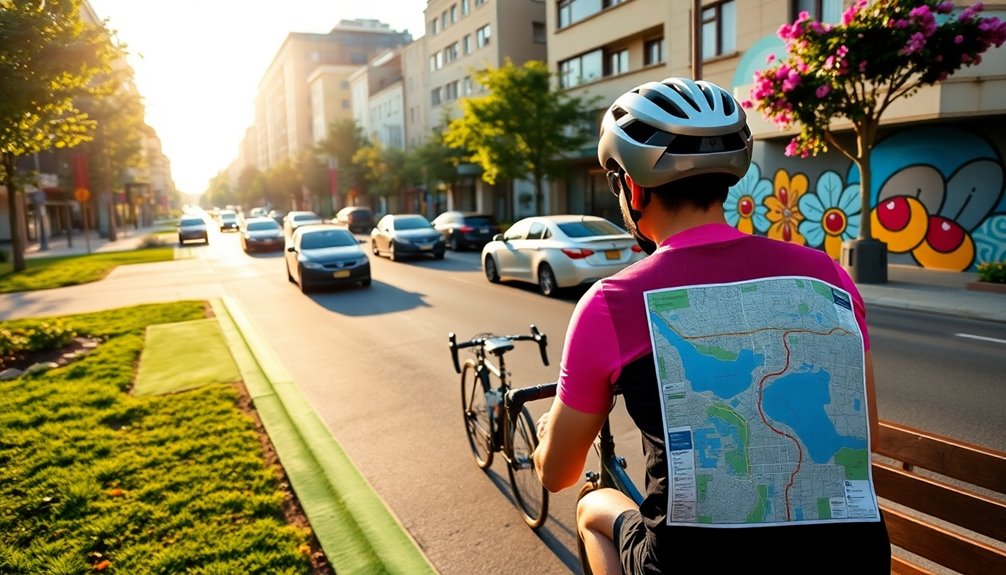
How can you ensure your cycling commute is both efficient and enjoyable? Start by using route planners like Google Maps or CycleStreets to find specific cycling routes.
Explore digital maps to identify quieter roads and off-road paths that keep you away from traffic. Consider tools like Ride with GPS for detailed satellite views and practice rides to test your chosen routes.
Aim for paths that minimize hills and incorporate shortcuts through residential areas. Don't forget to benchmark your travel time and adjust based on weather or daylight conditions.
Finally, use cycling apps for turn-by-turn directions and feel free to customize your route to match your preferences for speed, scenery, and tranquility.
Happy cycling!
Safety Tips for Cyclists

While cycling can be a refreshing way to commute, ensuring your safety on the road is essential. Always wear a properly fitted helmet and opt for bright or reflective clothing to increase your visibility.
Equip your bike with front and rear lights, along with reflectors, especially in low-light conditions. Follow traffic signals and use bike lanes when available. Signal your turns clearly to communicate with drivers.
Stay alert, avoid distractions, and anticipate hazards like car doors or pedestrians. Maintain a controlled speed, especially on wet surfaces, and secure your belongings to prevent distractions.
Encouraging a Bike-Friendly Workplace
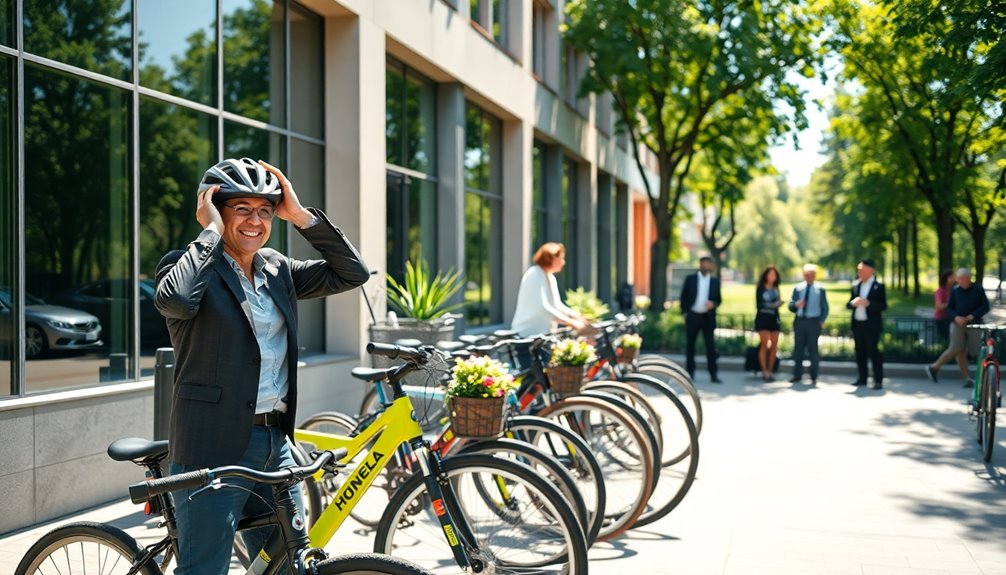
Creating a bike-friendly workplace not only promotes health and sustainability but also enhances employee morale and satisfaction.
You can start by providing secure bicycle lock-up areas, so everyone feels safe leaving their bikes. Offering lockers for active wear and shower facilities ensures that cyclists can freshen up before starting their day. On-site maintenance tools and bike repair services can also make cycling more convenient.
Consider implementing incentives like cash bonuses for regular bike commuters or discounts at local bike shops.
Flexible working arrangements and guaranteed ride-home programs will support your biking employees.
Building a Cycling Community
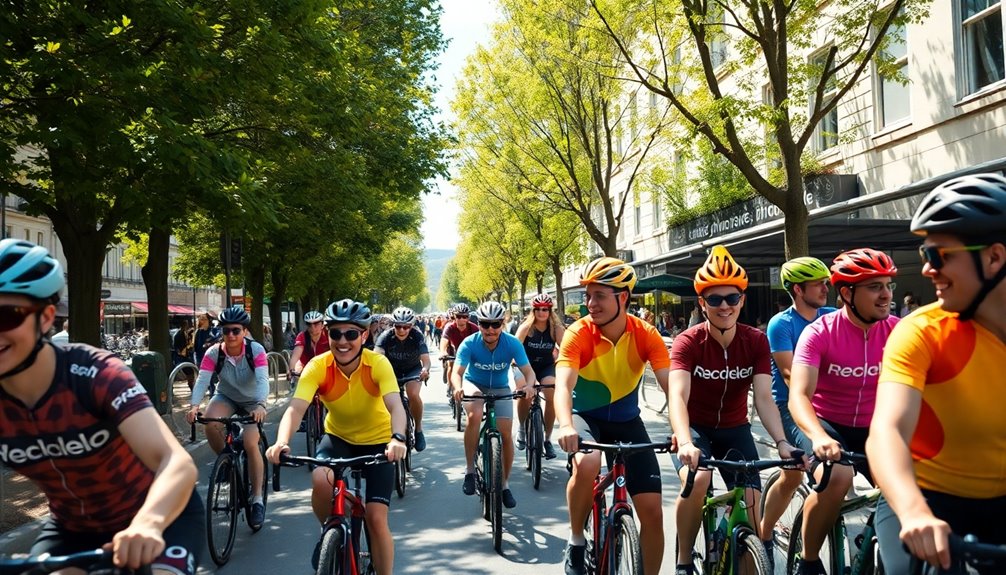
A vibrant cycling community fosters connections among riders and enhances the overall cycling experience.
By building dedicated bike lanes and connecting trails, you create safer routes that encourage more people to cycle. Adequate bike parking near public transport and popular spots makes your community more accessible.
Creating dedicated bike lanes and accessible parking encourages safer cycling and enhances community connectivity.
Organize events and establish local cycling groups to promote social interaction and shared knowledge among cyclists. Offering workshops on bike maintenance and safety can boost skills and confidence.
Don't forget to promote helmet use and provide safety courses for all ages. By collaborating with local businesses, you can enhance cycling culture while stimulating the local economy.
Ultimately, a supportive cycling community benefits everyone through improved health and connectivity.
Frequently Asked Questions
How Do I Maintain My Bike for Optimal Performance?
To maintain your bike for optimal performance, start with regular pre-ride checks.
Ensure tire pressure's right, brakes function properly, and the chain's clean and lubricated. Tighten bolts and inspect cables.
Perform regular maintenance tasks like cleaning the drivetrain and washing your bike.
Consider professional tune-ups every six months and track your maintenance activities.
Lastly, replace worn components promptly to keep your bike running smoothly and efficiently.
What Should I Wear While Cycling for Comfort and Safety?
You wouldn't believe how much a good outfit can enhance your ride!
For comfort and safety, wear moisture-wicking fabrics that keep you dry and cool. Opt for form-fitting clothing to reduce drag, and don't forget a helmet to protect your head.
Reflective elements boost your visibility, while padded shorts make long rides more enjoyable.
Layer up for changing weather, and choose closed-toe shoes for better traction.
Enjoy your ride while feeling comfortable and secure!
How Can I Transport My Belongings While Biking?
To transport your belongings while biking, consider using panniers for larger loads, as they keep your bike balanced.
If you need something lighter, baskets or milk crates work well for small items.
Backpacks are great for easy access and can hold personal items securely.
Don't forget to choose waterproof options if you expect rain.
Lastly, keeping your bike well-maintained ensures a smoother ride while carrying your essentials.
Are There Any Cycling Apps That Can Assist Me?
Imagine gliding through the streets like a leaf on a breeze; cycling apps can make that journey smoother.
Strava lets you track your rides and connect with friends, while Komoot helps you plan scenic routes tailored to your skill level.
If you need navigation, Bikemap provides real-time updates and millions of user-generated routes.
Cyclemeter turns your phone into a cycling computer, giving you detailed stats to enhance your performance on every ride.
What Are Common Cycling Etiquette Rules I Should Follow?
When you're cycling, following common etiquette is essential for safety and courtesy.
Always obey traffic laws and use hand signals to indicate your movements. Ride with the traffic flow and maintain visibility, especially at night.
On shared paths, yield to pedestrians and announce your presence when passing. If you're in a group, communicate clearly and avoid sudden moves.
Respect all trail users, and always check local regulations regarding e-bikes.
Conclusion
Integrating cycling into your daily commute not only benefits your health but also helps the environment. Imagine biking to work, feeling the wind on your face, and arriving energized instead of stressed. For instance, a local tech company encouraged employees to cycle by offering secure bike storage and shower facilities, resulting in a 30% increase in staff cycling to work. By making small changes, you can enjoy your ride while creating a healthier, more sustainable community.
